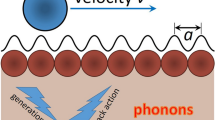Abstract
FRICTION between dry surfaces plays a role in solid dynamics over a wide range of length scales, from the mechanics of micromachines to earthquakes. Some common features of frictional dynamics have been observed for rather different materials, such as rock sliding on rock or metal on metal1,2. But there is still relatively little understanding of the way in which frictional motion varies generically with mechanical parameters. Here we present the results of experiments on frictional sliding of Bristol board, which show how the characteristics of frictional sliding depend on mass, driving velocity and stiffness of the driving spring constant. In general, there is a bifurcation from stick–slip to steady sliding with increasing velocity. The character of the frictional motion and of the associated bifurcation changes with velocity: at low speeds creep is dominant, which can be ascribed a characteristic length, whereas at high speeds the motion can be described as inertial, with a characteristic timescale. The kinetic friction coefficient decreases with increasing velocity in the former case, and increases with velocity in the latter. We anticipate that these results are likely to be generic.
Similar content being viewed by others
References
Rabinowicz, E. Friction and Wear of Materials (Wiley, New York, 1965).
Scholz, C. H. The Mechanics of Earthquakes and Faulting, Ch 2 (Cambridge Univ. Press, 1990).
Bowden, F. P. & Tabor, D. The Friction and Lubrication of Solids Ch 5 (Clarendon, Oxford, 1950).
Oden, J. T. & Martins, J. A. C. Comp. Math. appl. mech. Engng. 52, 527–634 (1985).
Jeager, H. M. & Nagel, S. R. Science 255, 1523–1531 (1992).
Yoshizawa, H., McGuiggan, P. & Israelachvili, J. Science 259, 1305–1308 (1993).
Brace, W. F. & Byerlee, J. D. Science 15, 990–992 (1966).
Jackson, E. A. Perspectives of Nonlinear Dynamics (Cambridge Univ. Press, 1986).
Dieterich, J. H. J. geophys. Res. 84, 2161–2168 (1979).
Rice, J. R. & Ruina,, A. L. J. appl. Mech. 50, 343–349 (1983).
Gu, Y. & Wong, T.-F. in Rock Mechanics Proc. 33rd US Symp. (eds Tillerson, J. R. and Wawersik, W. R.) 151–158 (Balkema, Rotterdam, 1992).
Rice, J. R. J. geophys. Res. 98, 9885–9907 (1993).
Marone, C. & Kilgore, B. Nature 362, 618–621 (1993).
Author information
Authors and Affiliations
Rights and permissions
About this article
Cite this article
Baumberger, T., Heslot, F. & Perrin, B. Crossover from creep to inertial motion in friction dynamics. Nature 367, 544–546 (1994). https://doi.org/10.1038/367544a0
Received:
Accepted:
Issue Date:
DOI: https://doi.org/10.1038/367544a0
- Springer Nature Limited
This article is cited by
-
Slip-rate-dependent friction as a universal mechanism for slow slip events
Nature Geoscience (2020)
-
Rate-, state-, and pressure-dependent friction model based on the elastoplastic theory
Friction (2020)
-
Precursory changes in seismic velocity for the spectrum of earthquake failure modes
Nature Geoscience (2016)
-
Laboratory observations of slow earthquakes and the spectrum of tectonic fault slip modes
Nature Communications (2016)
-
Dislocation Structure and Stick–Slip Phenomenon
Tribology Letters (2014)





